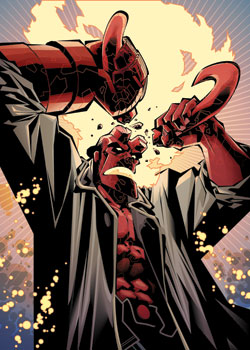As soon as we had the Hellboy license in hand, I was first in line to take the lead design duties. I’m a big Hellboy fan, coming to it by way of my love of the Cthulhu mythos. I had a pretty good idea of what I wanted the two decks to do even before I got the go-ahead from Humpherys. All of my ideas exploded into a file over a three-day period, and I had my first pass done before most people knew I had started work on it.
My original theme for the Thule Society had them stealing stunned characters, with the intent to sacrifice them for nefarious purposes.
 Grigori Rasputin
Grigori Rasputin
4-drop
8 ATK / 6 DEF
“Leader: KO an adjacent character >>> Move target stunned character to your front row if its cost is less than the cost of the character you KO'd. Use this power only once per turn.”
Conqueror Worm
6-drop
12 ATK / 12 DEF
“Whenever Conqueror Worm stuns a character, put a +1 ATK / +1 DEF counter on Conqueror Worm. <p> Vengeance: Whenever Conqueror Worm becomes stunned, you may KO it. If you do, move target stunned character to your front row. (You gain control of it.)”
Ragna Rok Engine
1-cost Equipment
“Whenever equipped character stuns a B.P.R.D. defender with a lower cost, move that stunned character to your front row. (You gain control of it.)”
When I showed the guys the designs, they of course had to remind me that I had already designed a lot of character stealing in the JLA set. They didn’t mind that the Ragna Rok Engine hosed a specific team, however. Since the two theme decks would be played against each other more often then not, naming a specific team to hose was perfectly fair game. A card like Project Ragna Rok would probably be too powerful if it could KO any stunned character, but specifically naming the B.P.R.D. makes it interesting in theme deck play while keeping it from being broken in tournament play.
For the Thule Society’s other theme, I thought the monsters Hellboy faces would make great Army characters. My initial designs were reasonable (some made it to print unchanged), but the developers wanted a little more excitement.
Huge, Annoying Tentacles
4-drop
6 ATK / 8 DEF
“Activate >>> Exhaust target B.P.R.D. character with cost 4 or less. Use this power only during your attack step.”
The Tentacles were intended to stop Hellboy, but the developers were correct in saying that Hellboy needed to be fighting every turn. Seeing him exhausted without a confrontation in half the games wouldn’t make for much excitement. I wanted the Thule Society to have some ways to get to the later turns, where finishing Project Ragna Rok would be an option, but this wasn’t the way to do it. They ended up with some endurance gain cards instead.
 For the Bureau for Paranormal Research and Defense, I knew I wanted to do an equipment theme and a theme revolving around Hellboy. Here are a couple of my original concepts that didn’t make it.
For the Bureau for Paranormal Research and Defense, I knew I wanted to do an equipment theme and a theme revolving around Hellboy. Here are a couple of my original concepts that didn’t make it.
Lobster Johnson
5-drop, Concealed—Optional
9 ATK / 9 DEF
You may recruit equipment onto Lobster Johnson as if it has concealed—optional.
Hellboy
4-drop
7 ATK / 7 DEF
Whenever Hellboy stuns a character, if he is the only visible character you control, KO that stunned character and put a +1 ATK / +1 DEF counter on Hellboy.
Lobster was problematic. Even some experienced players don’t understand the hidden area as it pertains to equipment, so how could we confuse new players like this? In a product that is partly designed for newer players, you don’t want to break a rule before you even teach it. The developers were also worried that some equipment would be far too powerful in the hidden area (like [Flamethrower]).
This version of Hellboy was an attempt to make him work well for both teams in an eventual team-up, but instead he felt out of place in both. The developers reminded me that it was fine to be thinking of team-up possibilities, but each team needed a unique theme. In order for the decks to have good replayability against each other, you want each deck to have a unique play experience—otherwise it gets stale quick.
So, with a firm grasp of how to theme the decks, it was now only a matter of including all of the characters from the Hellboy tales into two theme decks. My plan from day one was to see the characters’ drop order somewhat reflect the same time sequence as the events in the books.
· Turn 1 represents World War II. We see baby Hellboy and the soldiers on both sides of the conflict.
· Turns 2 and 3 describe the years in which we find the people who taught Hellboy to be the paranormal investigator he is today. On the Thule side, we are introduced to Rasputin’s support team and the ones who bring him back from his long slumber.
· Turns 4-6 cover the present day. The bulk of Hellboy’s comic book adventures are played out during these turns.
· Turns 7 and 8 represent the future—as least as Rasputin would like to see it. Hellboy’s destiny looms large over his head. Every time they meet up, you don’t quite know how things will pan out.
If your games play out following a timeline close to the events in the books, that should be fun. But if you come across some interesting interactions that could have been, that should have been, or that maybe even will happen someday, then I think we’ve really hit upon something grand.